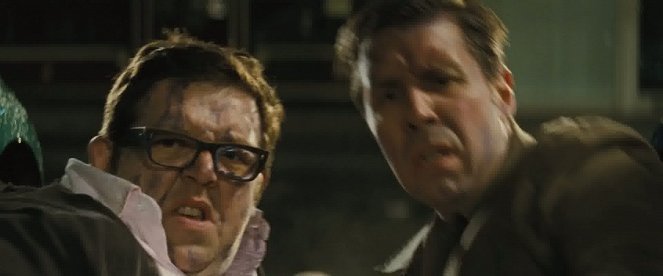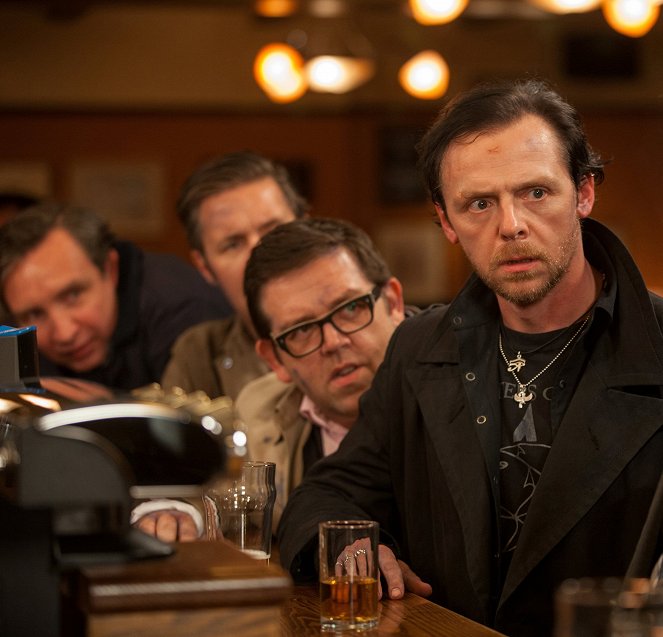Directed by:
Edgar WrightCinematography:
Bill PopeComposer:
Steven PriceCast:
Simon Pegg, Nick Frost, Martin Freeman, Rosamund Pike, Eddie Marsan, Paddy Considine, Pierce Brosnan, David Bradley, Bill Nighy, Mark Heap, Rafe Spall (more)VOD (3)
Plots(1)
20 years after attempting an epic pub crawl, five childhood friends reunite when one of them becomes hell bent on trying the drinking marathon again. They are convinced to stage an encore by mate Gary King, a 40-year old man trapped at the cigarette end of his teens, who drags his reluctant pals to their home town and once again attempts to reach the fabled pub, The World's End. As they attempt to reconcile the past and present, they realize the real struggle is for the future, not just theirs but humankind's. Reaching The World's End is the least of their worries. (official distributor synopsis)
(more)Videos (22)
Reviews (11)
I'll be upfront — I've got a soft spot for Simon Pegg. But even with that bias aside, this film landed as my least favorite among his works, both as an actor and a screenwriter. Why? It felt like a rehash of Shaun of the Dead with a few tweaks. And frankly, that just doesn't cut it for me. The cast looked promising and I couldn't wrap my head around why this film had such a low rating. Well, now I get it. Compared to Shaun, Hot Fuzz, and Paul, this one fell noticeably short, leaving me with the impression that Pegg might've rushed through the screenplay. Aside from a handful of standout moments, I found myself less entertained than usual — even bordering on boredom, which is a first for me with the Pegg/Frost duo. The only silver lining? I finally understand why they use blue blood in certain ads. / Lesson learned: When things don't go as planned, don't lose your head.
()
It’s good, but my expectations were higher. Hot Fuzz set the bar very high, blending with more grace the serious plot of a thriller with parody. The World's End tries to blend this style of humour with a horror sci-fi thriller, but it grinds a bit (though not as much as, in my opinion, Shaun of the Dead), sometimes the humour is too much, sometimes not enough. What I’m most sorry about is the weird and unnecessary end-credits scene, it ruins the positive impression of the bold and surprising twist with which the film had won me over.
()
If you are not already put off by its length, don’t read this review if you have not seen The World’s End yet. It is probably the most mature film that this bunch of eternal nerds is able to make. Just like in the previous parts of the trilogy, to which it is connected by the “jumping over a fence” gag and the green Cornetto wrapper in the epilogue, this time the development of the relationship between Pegg and Frost adds dynamics to the narrative. However, their long-standing friendship is thematised by the film and The World’s End can be seen as a tour of film genres whose story axis can be either the strengthening or disintegration of a friendship. After the prologue in the style of high-school comedies, we find ourselves in the realm of a bitter recapitulation comedy that, at the moment when it could start to come across as clichéd and sentimental, turns into an action/sci-fi horror flick with robots full of blue gunk. The epilogue then throws in a post-apocalyptic adventure and perhaps even some vampirism (or am I the only who thought Pegg looked like Vampire Hunter D?). Each of the newly introduced genres does not displace the one that came before, but in some way enhances it so that, for example, the debts paid by the protagonists are always higher (in the end, it’s much more than just 600 pounds). Stacking up motifs inherent to numerous types of films logically results in an intentionally overwrought climax whose anti-climactic point parodies the epic endings of serious sci-fi films. ___ The filmmakers’ ambitions to go to greater depths are most apparent in the greater sophistication of the characters. Gary is mentally stuck in the past, which he refuses to leave behind. He again embarks on a partially completed endeavour, using the same seductive tricks and driving the same car. However, his outlandish behaviour draws attention away from his dependence on his friends (borrowed money, the car registered in Peter’s name), whom he accuses of being envious, though it is clear that there are a lot of reasons for him to envy them instead and that the others actually serve mainly as a means for him to egotistically bolster his own feeling of importance (he dominates the shots with his friends like a real “king”). ___ The placement of the altogether authentic heroes in the context of a mythical narrative, which is explicitly pointed out to us only in the epilogue, attest to Wright’s fondness for surprising viewers by creating unexpected contrasts, though the names of the protagonist (King) and his car (Beast) and references to the Bible and The Three Musketeers can also be considered indicative of this. The friends’ get-together is thus shot from the beginning in a boisterous style that accentuates even the entirely unimportant moments as if they were the climax of an action blockbuster: “action” close-ups of objects, super-fast cuts in the dialogue, spectacular transitions between shots, inspiration taken from the aesthetics of comic books (the scene that looks like a strip of images) and video games (fight scenes viewed from a third-person perspective). Like Gary, who only slowed downs for stop lights, Wright refuses to stop, forcing the protagonists to resolve unsettled disputes from the past while massacring hordes of robotic aliens. Because the characters are traumatised by, for example, bullying or a very unpleasant traffic accident, another kind of tension that prevents the film from stagnating arises between its amusing form and its content suitable for a psychological chamber play. ___ Thanks to the ceaseless intertwining of the serious and the playful, Wright can, for example, fearlessly use the well-known “who’s infected” scene from Carpenter's The Thing as a model for the confidence game. The question of who is actually human and what form authentic humanity has in the current era, choked with demands for uniform perfection, permeates the film, so this does not involve a gratuitous allusion that would be exhausted by revealing it (the broken back à la Bane, for example, fits into this category). Regardless of the numerous other quoted films about the robotisation of the globalised world (e.g. Village of the Damned) and humanity’s extraordinary talent for self-destruction (e.g. Soylent Green), Wright manages to combine outside sources in an original and entertaining way, so the result doesn’t disintegrate into isolated scenes. ___ The carefully thought-out structure of the film, which at first may seem to be an unorganised multi-genre mess, becomes apparent upon repeated viewings. The group arrives at the first pub and the first indication that places are also losing their form comes after a twenty-minute exposition, during which we get to know all of the protagonists in rough outlines. The first twist – the initial fight with robots – comes after not quite forty minutes. A new goal is established at the 45-minute mark (or rather the original goal, which everyone except Gary wanted to abandon, is restored). An hour into the film, we learn some important information about the way the people are being “lobotomised”. The goal (the last pub) is achieved twenty minutes before the end, when all of the storylines converge and the time comes for the denouement, the protagonists’ confrontation with themselves. A bonus for attentive viewers is the director’s obsession with numbers, which are hidden throughout the film in accordance with the number of pubs that the protagonists visit in succession. In the third pub, Gary drinks three beers; in the seventh, Steve points out that he has already drunk seven pints; after they leave the eighth pub, we find out that Adrian died eight years prior in Italy; at the ninth, there is a sign with the numeral 9, and so on. On the second viewing, you may notice that roughly two-thirds of the events repeat (again, the motif of recycling) what Gary and his friends had previously experienced in high school (in both cases, first Oliver falls away, then Sam, then Peter). ___ The frenetic pace of the narrative makes The World’s End a film that is impossible to fully appreciate with just one viewing and which every (im)mature nerd will gladly watch again and again. Well, maybe not every nerd, but definitely me. 90%
()
(less)
(more)
Wright, Pegg and Frost are back and in excellent form, this time in a beer-drinkers’ sci-fi about the threat of technology taking over. Almost non-stop situation gags, the action looks like a typical bar fight, crossed with kung-fu. The special effects are excellent, the story gets you thinking. Welcome to the end of the world!
()
Simon Pegg, Nick Frost and Edgar Wright meet for the third time in a row. And for the third time in a row, do a decent job. It’s no longer so much fun as Shaun of the Dead but it’s still good. It’s not as much about fun rather than about the boys getting together and shooting another crazy but good movie, this time poking fun at sci-fi. Moreover, I saw The World’s End after about six beers, so my rating reflects that. Nevertheless, I think that had I not returned from a pub, I’d have opened a beer while watching this, because a movie like this needs that. As pubs are its subject matter, it’s hard not to think about beer during the first five minutes. Anyhow, the boys managed to get a great cast for their movie – Freeman, Marsan and Considine were really cool. Each of them did their own thing and it fit the movie well. I wouldn’t mind going on a beer trip like this, maybe except for the global consequences. I’d give those a pass. But the rest was a wild ride indeed.
()



Ads